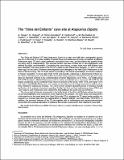Por favor, use este identificador para citar o enlazar a este item:
http://hdl.handle.net/10261/22440COMPARTIR / EXPORTAR:
 SHARE SHARE
 CORE
BASE CORE
BASE
|
|
| Visualizar otros formatos: MARC | Dublin Core | RDF | ORE | MODS | METS | DIDL | DATACITE | |

| Título: | The “Sima del Elefante” cave site at Atapuerca (Spain) |
Autor: | Rosas, Antonio ; Huguet, Rosa CSIC ORCID; Pérez-González, Alfredo; Carbonell, Eudald CSIC; Bermúdez de Castro, José María; Vallverdú, Josep CSIC ORCID; Van der Made, Jan ; Allué, E.; García, Nuria; Martínez-Pérez, R.; Rodríguez Méndez, Jesús CSIC ORCID; Sala, Roser; Saladie, Palmira; Benito Calvo, A.; Martínez-Maza, Cayetana; Bastir, Markus CSIC ORCID ; Sánchez Marco, Antonio CSIC ORCID; Parés, Josep María | Palabras clave: | Early Pleistocene Middle Pleistocene Human occupation Mediterranean ecosystems Paleoecology Site formation Pleistoceno inferior Pleistoceno medio Ocupación humana Ecosistemas mediterráneos Paleoecología Formación del yacimiento |
Fecha de publicación: | 30-dic-2006 | Editor: | Consejo Superior de Investigaciones Científicas (España) | Citación: | Estudios Geologicos 62(1): 327-348 (2006) | Resumen: | [EN] The “Sima del Elefante” (TE site) (Atapuerca, Spain) is a major cave infill with a stratigraphic succession
25 m thick and 15 m wide, wealthy in animal bones and evidences of human occupation at different
Pleistocene ages. TE site is under systematic excavation since 1996, and the inferior and superior levels
are being dug up independently. The exposed section has been divided into 21 lito-stratigraphic units
defined by major unconformities. Concerning the cave history, at least three main infill phases have
been identified. The lower phase (TE8-TE14) is dated to Early Pleistocene (between 1.1 and 1.4 million
years ago) on the basis of inverse paleomagnetics and belonging to the later Early Pleistocene on the
basis of biochronology. The TE lower phase is providing a rich faunal assemblage, and shows evidence
of human occupation. A set of stone tools of flint, and possibly, calcareous, is being found at these levels.
Hence, the lower part of the TE section documents early presence of hominids in Europe and constituted
an important element in the understanding of human dispersions out-of-Africa. The middle phase
(TE15-TE19) dated to Middle Pleistocene and it is further sud-divided into a basal part (TE15-TE17), still
largely unexplored, but no vertebrate fossil record is present at this levels. Units TE18, and mainly TE19
unit, date to late Middle Pleistocene, and contain an abundant record of large mammals as well as stone
tools included in calcareous breccias. The TE19 G level contains abundant pieces of charcoal, though
verification of its antropic character is pending. Finally, the third and last sedimentary phase (TE20 and
TE21) date to Last Pleistocene and it defined the final infilling of the cavity and soil formation.
The chronological intervals represented in the fertile levels of the Sima del Elefante enlarge the temporal
and biostratigraphic local succession at the Atapuerca Hill complex. The lower phase was deposited in
a time previous to the lower levels from Gran Dolina site (TD4), whereas the TE upper levels possibly correspond
to a moment later than the sedimentation of Galería GIII/GIV, and Gran Dolina TD10/TD11. In
addition, the structural features of the TE site together with its sedimentary and arqueo-paleontological
record allow the eventual exploration of problems that remain unresolved in other Atapuerca cave sites. [ES] El yacimiento de la Sima del Elefante (TE) (Atapuerca, España) se localiza en el extremo sur de la trinchera del ferrocarril de la Sierra de Atapuerca. TE constituye una sección transversal de una antigua galería kárstica totalmente colmatada de sedimentos pleistocenos. La secuencia estratigráfica completa alcanza los 25 m de potencia y ha sido dividida en 21 unidades lito-estratigráficas delimitadas por discontinuidades mayores. La historia de la cavidad puede ordenarse en al menos tres fases. La fase inferior (niveles TE8 a TE14) data del tercio final del Pleistoceno Inferior, con una cronología entre 1.1 y 1.4 millones de años. Es rica en registro arqueo-paleontológico y presenta claras evidencias de actividad antrópica. Dada su cronología, los niveles inferiores de TE representan un importante referente para la comprensión de la primera colonización humana de Europa. La fase intermedia la constituyen las unidades TE15 a TE19. El tramo basal de esta segunda fase de relleno (TE15 a TE17) hasta la fecha no ha deparado contenido fósil. El tramo superior (TE18 y TE19), cuya cronología parece corresponder a la parte final del Pleistoceno Medio, es rica en restos de grandes mamíferos e industria lítica sobre sílex y cuarcita. La unidad TE19 se caracteriza por una sucesión de coladas detríticas (“debris-flow”) (TE19A a TE19G), con matriz muy dura y carbonatada, rica en huesos de grandes mamíferos y ausencia de micromamíferos. El nivel TE19G contiene abundantes restos de carbón pendiente de verificar su posible carácter antrópico. Finalmente, la tercera y última fase de relleno (TE20 y TE21) corresponde al Pleistoceno superior y se define por la colmatación final de la cavidad y formación de un horizonte edáfico. Los intervalos cronológicos representados en los niveles fértiles de la Sima del Elefante (TE) complementan la secuencia cronológica y bioestratigráfica local del complejo Atapuerca. La fase inferior de TE tuvo lugar en un tiempo anterior a los niveles inferiores de Gran Dolina (TD4), mientras que el relleno de las unidades superiores de TE corresponde a un momento posterior a la sedimentación de GIII/GIV de Galería y TD10/TD11 de Gran Dolina. |
Descripción: | 21 pages, 10 figures, 1 table. | Versión del editor: | http://dx.doi.org/10.3989/egeol.0662129 | URI: | http://hdl.handle.net/10261/22440 | DOI: | 10.3989/egeol.0662129 | ISSN: | 0367-0449 | E-ISSN: | 1988-3250 |
| Aparece en las colecciones: | (MNCN) Artículos |
Ficheros en este ítem:
| Fichero | Descripción | Tamaño | Formato | |
|---|---|---|---|---|
| 28.pdf | 1,57 MB | Adobe PDF |  Visualizar/Abrir |
CORE Recommender
Page view(s)
557
checked on 23-abr-2024
Download(s)
900
checked on 23-abr-2024
Google ScholarTM
Check
Altmetric
Altmetric
NOTA: Los ítems de Digital.CSIC están protegidos por copyright, con todos los derechos reservados, a menos que se indique lo contrario.
